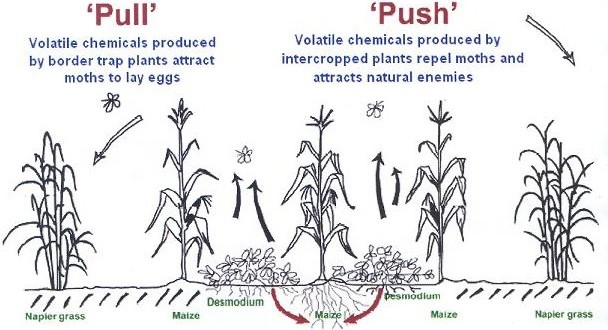The Push-Pull technology involves use of behaviour-modifying stimuli to manipulate the distribution and abundance of stemborers and beneficial insects for management of stemborer pests (Figure above). It is based on in-depth understanding of chemical ecology, agrobiodiversity, plant-plant and insect-plant interactions, and involves intercropping a cereal crop with a repellent intercrop such as desmodium (push), with an attractive trap plant such as Napier grass (pull) planted as a border crop around this intercrop. Gravid stemborer females are repelled from the main crop and are simultaneously attracted to the trap crop. Napier grass produces significantly higher levels of attractive volatile compounds (green leaf volatiles), cues used by gravid stemborer females to locate host plants, than maize or sorghum. There is also an increase of approximately 100-fold in the total amounts of these compounds produced in the first hour of nightfall by Napier grass (scotophase), the period at which stemborer moths seek host plants for oviposition, causing the differential oviposition preference. However, many of the stemborer larvae, about 80%, do not survive as Napier grass tissues produce sticky sap in response to feeding by the larvae which traps them causing their mortality. Legumes in the Desmodium genus (silverleaf, D. uncinatum and greenleaf, D. intortum), on the other hand produce repellent volatile chemicals that push away the stemborer moths. These include (E)-ß-ocimene and (E)-4,8-dimethyl-1,3,7-nonatriene, semiochemicals produced during damage to plants by herbivorous insects and are responsible for the repellence of desmodium to stemborers.
Desmodium also controls striga, resulting in significant yield increases of about 2 t/ha per cropping season. In the elucidation of the mechanisms of striga suppression by D. uncinatum, it was found that, in addition to benefits derived from increased availability of nitrogen and soil shading, an allelopathic effect of the root exudates of the legume, produced independently of the presence of striga, is responsible for this dramatic reduction in an intercrop with maize. Presence of blends of secondary metabolites with Striga seed germination stimulatory, 4′′,5′′,-dihydro-5,2′,4′-trihydroxy-5′′,-isopropenylfurano-(2′′,3′′;7,6)-isoflavanone, and post-germination inhibitory, 4′′,5′′-dihydro-2′-methoxy-5,4′-dihydroxy-5′′-isopropenylfurano- (2′′,3′′;7,6)-isoflavanone, activities in the root exudates of D. uncinatum which directly interferes with parasitism was observed. This combination thus provides a novel means of in situ reduction of the striga seed bank in the soil through efficient suicidal germination even in the presence of graminaceous host plants in the proximity. Other Desmodium spp. have also been evaluated and have similar effects on stemborers and striga weed and are currently being used as intercrops in maize, sorghum and millets.
|


 Research Partners
Research Partners